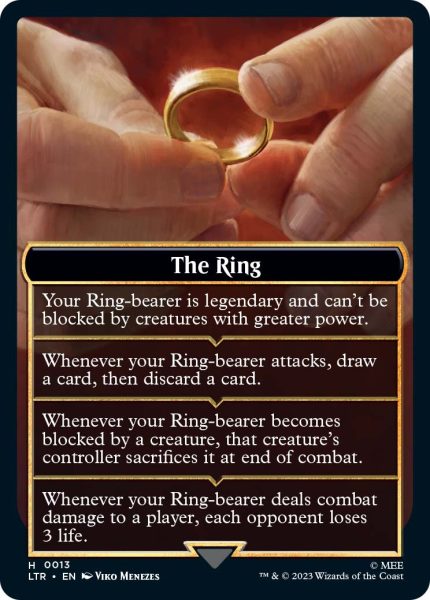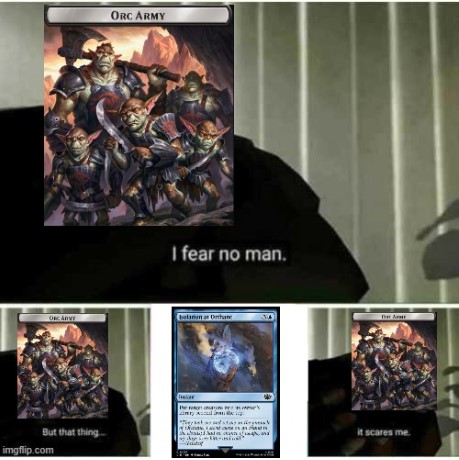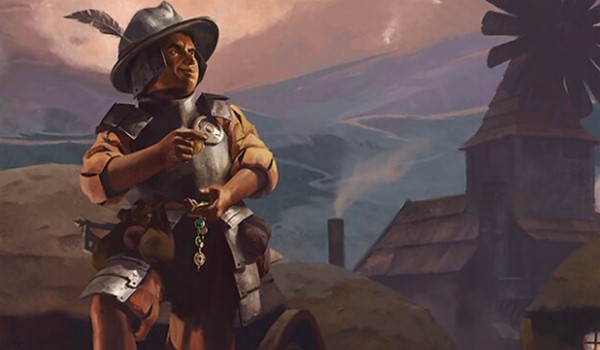Are you a Quiet Speculation member?
If not, now is a perfect time to join up! Our powerful tools, breaking-news analysis, and exclusive Discord channel will make sure you stay up to date and ahead of the curve.
In a grindy BETW mirror-match, I had fallen to a precipitous life total. Fortunately, I had the tools to stabilize. Lotho, Corrupt Shirriff would trade on the ground with my opponent's Orc Army, and my freshly played Voracious Fell Beast would defend my life against the three Spirit tokens. I would untap, crack the Food, and the board would be in my favor with a grip of cards. Unfortunately, that's not what happened.
Because of poor sequencing, Lotho triggered, drawing me a card, creating me a Treasure and, most importantly, inflicting the loss of a single life. Next turn, I died to two of the three attacking spirits for exactly lethal.
Lord of the Rings: Tales in Middle Earth (LTR) is a format of small edges and costly mistakes. After the hyper-aggressive ONE and the princely MOM, LTR feels like a return to the basic fundamentals of Magic. Of all those fundamentals, sequencing is particularly important in the format. Today, we'll look at LTR's sequencing challenges and how they prove especially pertinent with two new mechanics, The Ring and amass.
What Is Sequencing?
Sequencing refers to the order in which we perform our game actions. In life, this could be as simple as putting the butter on the pancake before you pour the syrup on it. The syrup traps the butter to the warm, fluffy pancakes, thus making it easier to spread. If we put the syrup on the pancake first, the butter slips around, and we've got a whole situation on our hands.
In Magic, sequencing helps us optimize our gameplay. Some of it is simple: we want to put our equipment on a creature before it attacks, we want to cast our combat tricks after blocks are declared, etc. However, different circumstances call for different sequences.
In LTR the most common sequencing decisions involve the two keywords, amass and tempt. For both abilities, we need to consider whether to invest more into our current attack, or to prepare to rebuild should things go wrong.
A World of Sorceries
Instants let us sequence with flexibility. We can wait for an opponent to take a game action or to be at their most vulnerable before utilizing an instant-speed effect. LTR downgrades some familiar effects from instant to sorcery, typically offering tempt or amass as a payoff.
Slow it down
Because of this limitation, we want to be very careful as to how we plan our turns. Thoughtful sequencing is necessary for maximizing Orc Armies and Ring-bearers, as these game pieces are amongst the most important in the limited landscape.
Ring-bearer 101: Eggs vs. Basket
The default decision for both amass and tempt is to do it before combat. We want our attackers to be large, so we want to amass. The Ring's second level triggers when declaring attacks, while the first and third happen before blockers are declared. That value is all sequence-dependent, and we miss opportunities when we do this post combat.

We always have to ask how The Ring is contributing to our gameplan. The Ring makes small creatures evasive and eventually punishing to block. This should push decks in a more aggressive direction; however, the most significant ability is granted at level two. Looting every turn helps smooth out hands regardless of position.
If we can reliably attack with a level two Ring-bearer, we have an enormous advantage over opponents who can't. Level three can punish blockers, especially the 1/3s and 1/4s in the format, but what do we lose if we can't re-equip The Ring? Often times it is better to lose a looter in combat, and then tempt again to set up more looting for the future. This is especially true if we can generate value from the bearer on the way out.
For value's sake
Losing the Ring-bearer can mean our engine no longer functions. When deciding between the first three levels on the ring, we need to consider what we stand to lose if we can't tempt a new creature. The longer we anticipate the game going, the more valuable an active Ring-bearer will be.
BYOB: Build Your Own Bolt
Looting accrues advantage. We want to tap that advantage every turn if we can. An active Ring-bearer develops our hand and battlefield. But when we get to step four, the Ring's evasion becomes even more punishing, and the mechanic shifts to be even more aggressive.
Because it triggers after the other three, level four makes the best use of the instant-speed effects. The fourth level triggers when our creature does damage. So, in an ideal scenario, we can get the sacrifice trigger off a level three Ring when opponents declare blocks, and then move The Ring at instant speed to also get the level four trigger on an unblocked creature.
When we're playing a tempt-heavy deck, cards like Slip On the Ring and Dreadful as the Storm can overperform. They facilitate difficult attacks while passing the ring to an unblocked attacker. Sneaking in a Ring-bearer this way can earn us three damage. Whether we use The Ring's evasion or instant-speed tricks to supplement our pressure, free Lava Spikes should end the game quickly.
Sequencing with Ring-bearers often asks us to evaluate the current attack versus the possibility of future attacks. My heuristic is that I want to set up as many turns where I'm attacking with a Ring-bearer as possible.
Ring-bearers, landcycling, and scry
It's a basic virtue of sequencing that we want to do things as late as possible, as long we still reap the desired effect. Basically, the idea is that we get maximum information before committing to an action. So why would we ever landcycle before our looting trigger?
If we're digging for outs, it might make sense to thin our deck first. The landcycler can only fetch its corresponding basic. Getting that land out of the deck before looting raises our chances of drawing the card we need. Affecting the deck size after drawing may not do anything at all. And the land may be a good card to discard regardless.
Similarly, we usually want to sequence scry triggers before looting trigger. This will allow us to put the desired card in hand rather than draw randomly and set up the following turn. If we're hellbent and know this card will be tossed away, it makes more sense to scry after looting, so that we control a future card in hand rather than one milled to the graveyard.
When to Pass on Amass
An oversized Army token has ended many a game in LTR limited. It's very easy to get them to four power, and after that, they become a huge issue. Because bigger attackers hit harder, it often makes sense to play out amass pre-combat. However, caution has some value here.

Isolation at Orthanc matches up really well against Orc Armies. While I will routinely Torment of Gollum into an open four mana, I don't want to load up on amass if I'm staring down a potential Isolation. Again, we have to ask ourselves: how many eggs are we willing to put in one basket? Unlike The Ring's levels, when we lose our Orc Army, we have to start from scratch.
My goal with tempt is usually to attack with a level two or higher Ring-bearer as many times as possible. My goal with amass is to have the most +1/+1 counters left for the following turn. Both of these approaches need to take the game's pace into account, but provide a good place to start.
Both amass and tempt look to build out a single threat, but once that threat is neutralized, we are forced to regroup. When it comes to both effects, we want to think about what the value and goal of this combat compared to how we envision the rest of the game developing. With amass, my heuristic is more about removal. I want my creature to be big enough to demand removal, without being so big that I'm overcommitted. Once my opponent shows they can't interact with it, I'm more confident going all-in.
Thinking of Amasster Plan
When are small Armies better than large ones? If our plan is to convert tokens for value, it might make more sense to squeeze value from a token before amassing again. While red and blue often want to build a massive Orc Army and use it to pressure opponent life totals, BW cares more about the cardboard than the dice placed on it.
Make objects, make profit
To be fair, black has plenty of ways to use smaller amass tokens without white's support. Gollum, Patient Plotter, Gothmog, Morgul Lieutenant, and Cirith Ungol Patrol all like smaller tokens. Black's flexibility makes it the best color in the format.
There's some tension between these cards, though, and sorcery-speed effects like The Torment of Gollum or Dunland Crebain. Once we grow an amass token to 3/3 or 4/4, we're probably looking to do more with it than sacrifice it for value. Maximizing these resources over a series of turns can be complicated, and our decision is game-state dependent. Usually I'm asking myself, "am I ready to pressure their life total, or am I trying to grind value?"
All-In on LTR
I'm not one for Core Sets. I've heard them described as a pallet cleanser for the super complicated formats that cycle through the rest of the year. They've been explained to me as a soft reset to slow power creep. Sure. If you say so.
Furthermore, I'm not a huge fan of the Universe Beyond content. Worst of all, I have concerns about the pricing of this set and what it means for general product distribution.
Still, I have to admit, I'm completely smitten by this limited format. The power level rewards tight gameplay. Uncommon build-arounds really shine, and with a second "signpost uncommon," archetypes have more variation. Something about it reminds me of an older brand of Magic.
While that may just be the nostalgia of a 25-year veteran of the game, I've really enjoyed it so far. It rewards doing the small things right, and sequencing is a big part of that. So let me know what sequencing situations you've come across in your journeys of LTR.




